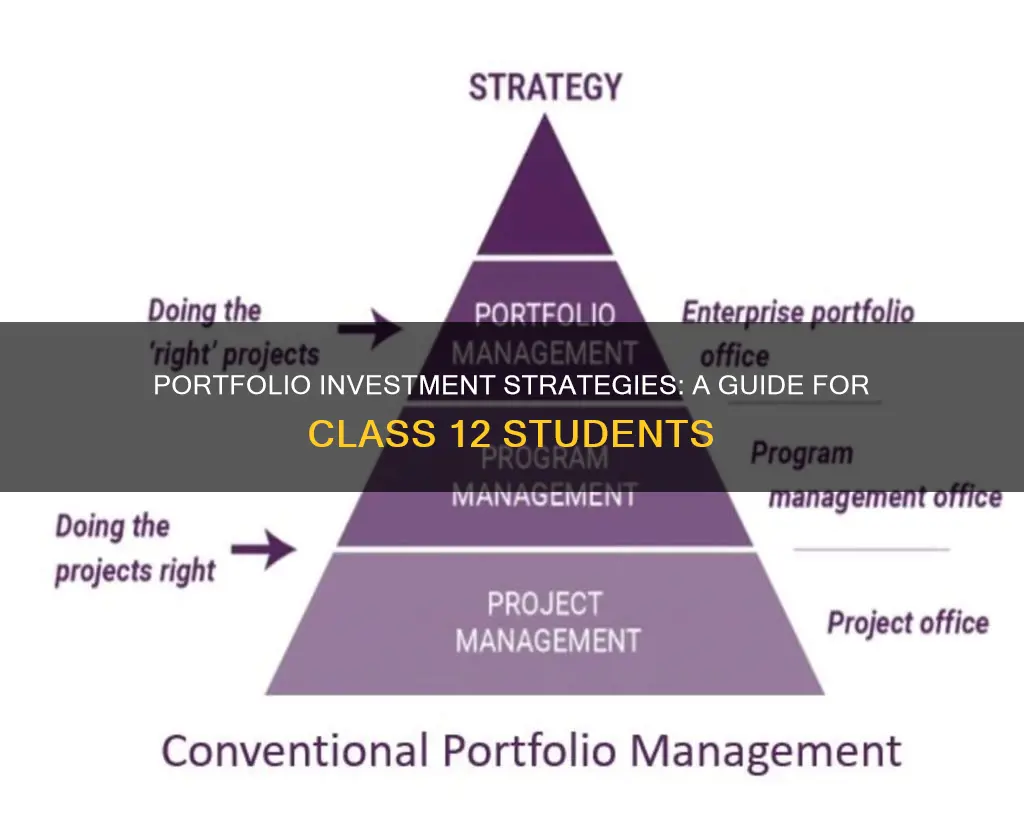
A portfolio investment is a strategic process of investing in a collection of financial assets, such as stocks, bonds, and other securities, with the expectation of earning a return or achieving capital growth. Portfolio investments are passive investments, meaning the investor does not actively manage the investment or the company. Foreign portfolio investment (FPI) is a type of portfolio investment where investors acquire financial assets in another country. FPI is one of the common ways for investors, especially retail investors, to participate in an overseas economy.
| Characteristics | Values |
|---|---|
| Definition | A collection of financial assets and investment tools held by an individual, a financial institution, or an investment firm |
| Types of Assets | Stocks, bonds, cash equivalents, real estate, commodities, gold, funds, derivatives, property, etc. |
| Investor Types | Individuals, companies, government agencies |
| Investor Control | Passive ownership; investors have no control over ventures or direct ownership of property or a stake in a company |
| Investor Expectations | Expectation of earning a return |
| Investor Risk | Directly proportional to the risk involved |
| Investor Returns | Returns earned can be calculated using money-weighted returns |
| Investor Diversification | An important strategy to manage risk and potentially improve returns |
| Investor Suitability | More suited to the average retail investor |
What You'll Learn

Foreign portfolio investment
FPI is one of the most common ways for investors to participate in an overseas economy, especially for retail investors. It is a way for investors to diversify their portfolios and access international markets, which can enhance their potential for higher returns. FPI also provides investors with a larger credit base, as they can access credit in the foreign countries they have invested in.
FPI is often compared with foreign direct investment (FDI), where investors purchase a direct business interest in a foreign country. FPI is generally more liquid than FDI and offers a quicker return on investment. However, FPI assets can be more volatile and prone to negative news or uncertainty in the foreign market.
Examples of countries that have attracted significant FPI in recent years include India and Brazil. Factors such as economic stability, growth prospects, favourable regulatory environments, and attractive returns drive the flow of FPI into a country.
Who Runs Berkshire's Investment Portfolio?
You may want to see also

Passive vs active management
Portfolio investment involves acquiring and managing a range of financial assets, such as stocks, bonds, and other securities, while balancing risk and maximising returns.
Passive management aims to replicate the performance of a specific index or benchmark. This is a cost-effective and low-maintenance investment option. For example, investing in a mutual fund or ETF that tracks an index like the S&P 500. Passive management involves purchasing assets held in a benchmark index, allocating a portfolio similar to a market index, and applying a similar weighting. It generally has lower fees as there is no fund manager to pay. However, the returns depend entirely on the performance of the index being tracked.
Active management, on the other hand, involves buying and selling assets with the goal of outperforming the market. This often requires extensive research and analysis of market trends, economic and political data, and company-specific news. Active management generally has higher fees due to the expertise and work involved. Active management may be able to spot opportunities or react to market downturns, and can sometimes beat the market index.
Both strategies have their advantages and can be used in combination to build a diversified portfolio. The choice between them depends on factors such as financial goals, risk tolerance, time horizon, and investment costs.
Saving vs. Investing: Ramsey's Key Differences Explained
You may want to see also

Risk and return
The level of risk an investor is willing to take on depends on their risk tolerance, financial goals, and investment timeline. Conservative investors, for instance, tend to favour investments with lower risk, such as bonds and cash equivalents, while aggressive investors are willing to take on more risk by investing in stocks and higher-risk assets.
One of the key risks associated with portfolio investment is volatility. This is particularly true for foreign portfolio investments (FPIs), where adverse events or negative news in a foreign country can trigger a sell-off, leading to economic disruption and a further decline in asset prices. FPIs are also subject to currency fluctuations, political instability, and different regulatory environments, all of which can impact the value of the investment.
Another risk to consider is the potential for loss of control. In FPIs, investors do not have direct control over the management or functioning of the business entity in which they invest. This lack of control can be a disadvantage if the business makes decisions that are not in line with the investor's interests.
On the other hand, portfolio investments can also help to mitigate risk through diversification. By spreading investments across different asset classes, sectors, and geographic regions, investors can reduce the impact of any single asset's poor performance on their portfolio. Diversification is a crucial strategy for managing risk and improving returns.
Additionally, regular portfolio rebalancing is important to maintain the desired asset allocation. Market movements can alter the composition of a portfolio over time, and rebalancing ensures that the investor's risk tolerance and financial goals remain aligned with their investment strategy.
In conclusion, risk and return are integral to portfolio investment decision-making. While portfolio investments carry various risks, these can be managed through careful diversification, regular rebalancing, and a clear understanding of the investor's risk tolerance and financial objectives.
Stress Testing Your Investment Portfolio: Strategies for Success
You may want to see also

Diversification
There are several approaches to diversifying a portfolio:
- Distributing investments across a wide range of vehicles, including cash, stocks, bonds, mutual funds, ETFs, and other financial instruments. It is important to seek out assets whose historical returns have shown little correlation, meaning they move independently of each other. This ensures that while one part of the portfolio may shrink, others could grow.
- Maintaining diversity within each asset category. For example, including securities that vary by sector, industry, geographic region, and market capitalization for stocks, and varying maturities and credit qualities for bonds.
- Investing in securities with different risk profiles. Including investments with varying levels of risk and potential returns can help balance a portfolio. This allows for the possibility that significant gains in higher-risk areas may offset losses in more stable investments.
The right mix of assets in a portfolio depends on the investor's risk tolerance, financial goals, and timeline. For instance, a young professional saving for retirement might allocate a higher percentage of their portfolio to stocks for growth potential, while a retiree might favour bonds for income and stability.
It is important to note that diversification does not guarantee profits or protect against losses. However, it is a strategy that can help investors manage their risk and work towards their financial goals.
College Savings vs Investments: Where Should Your Money Go?
You may want to see also

Investment types
FPI involves investors acquiring financial assets, such as stocks and bonds, in another country to diversify their portfolios. FPI does not provide the investor with direct ownership of a company's assets and is relatively liquid depending on the volatility of the market. FPI holdings can include stocks, American depositary receipts (ADRs), global depositary receipts (GDRs), bonds, mutual funds, and exchange-traded funds.
FDI, on the other hand, allows an investor to purchase a direct business interest in a foreign country. For example, an investor based in one country buys a restaurant chain in another country to lease to a company that needs space to expand its operations. The investor has control over their monetary investments and often actively manages the company they put money into. The investor helps to build the business and waits to see their return on investment (ROI). However, because the investor’s money is tied up in a company, they face less liquidity and more risk when trying to sell this interest.
Other types of investments include:
- Income-driven portfolios: Focused on securing a steady flow of income from investment avenues.
- Growth-oriented portfolios: Focused on growth stocks of companies in their active growth stage.
- Value-oriented portfolios: Focused on securing bargains in the investment market.
Building an Investment Portfolio: Teaching Kids About Money
You may want to see also
Frequently asked questions
A portfolio investment is a collection of financial assets owned by an individual, financial institution, or investment firm. It involves acquiring and managing a range of assets such as stocks, bonds, and other securities, while balancing risk and maximizing returns over time.
A portfolio investment is passive and does not involve taking an active role in the management of the company. In contrast, direct investment involves taking a sizeable stake in a target company and participating in its day-to-day management.
Common asset classes for portfolio investments include stocks, bonds, cash equivalents, real estate, commodities, and alternative investments like cryptocurrencies, private equity, or hedge funds.
The composition of investments in a portfolio may depend on factors such as investment horizon, risk tolerance, financial goals, and the amount of money being invested. It's important to diversify your portfolio to manage risk and improve returns.
Portfolio investments offer the advantage of diversification, allowing investors to spread their investments across different asset classes and geographic regions. This helps to manage risk and potentially improve returns over time. Additionally, portfolio investments are more affordable, feasible, and provide quicker returns compared to direct investments.







